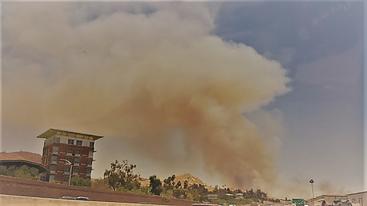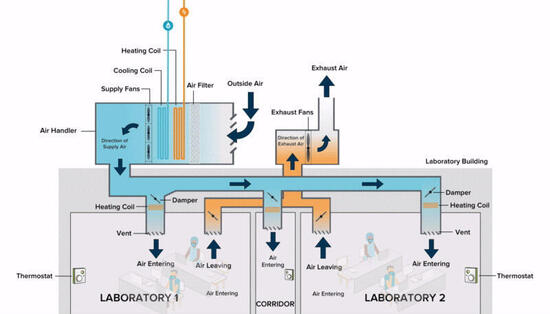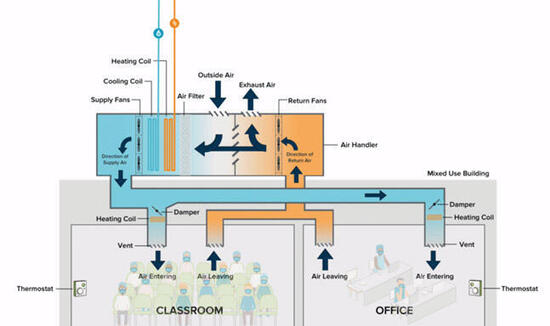Wildfire Smoke & Air Quality
Smoke from wildfires in Southern California may contribute to poor air quality in the Riverside area during the fire season. Be prepared!
Smoke can irritate the eyes and airways, causing coughing, a scratchy throat, and irritated eyes and sinuses. Substances released from fires far away, while very unlikely to cause any significant health hazards, can contribute to headaches, nausea, and dizziness. Elevated particulate matter in the air can trigger shortness of breath and/or wheezing in those who suffer from asthma, emphysema or COPD. For most people, the conditions in the Riverside area become unpleasant rather than dangerous. However, elderly persons, children, and individuals with respiratory illnesses are particularly susceptible to elevated air pollution levels and should take extra precautions to avoid exposure.
Wildfire Health Information
-
During a smoke event
- Smoke can irritate the eyes and airways, causing cough, a dry scratchy throat, runny nose, trouble breathing, and irritated sinuses. Stay hydrated by drinking water during heavy smoke events.
- Stay inside with the doors and windows closed, in your “clean room” with a HEPA filter if you have one. Seek shelter elsewhere if you do not have an air conditioner and it is too warm to stay inside with the windows closed.
- Do not add to indoor air pollution. Do not burn candles or use gas, propane, wood-burning stoves, fireplaces, or aerosol sprays. Do not fry or broil meat, smoke tobacco products, or vacuum. All of these can increase air pollution indoors.
- Take it easier during smoky times to reduce how much smoke you inhale. If it looks or smells smoky outside, avoid strenuous activities such as mowing the lawn or going for a run.
- Know your air quality. Stay tuned to local media for changes in smoke or weather conditions. Riverside information can be found at the EPA Air Nowwebsites.
- Long-term smoke events usually have periods when the air is better. When air quality improves, even temporarily, air out your home to reduce indoor air pollution, and step outside yourself when you have a chance!
-
What if I must be outside?
First, RECONSIDER: the only way to completely avoid potential health risks from both chemicals and particulates found in smoke is to avoid exposure. If you MUST be active outside in smoky areas, take steps to limit your time and level of activity outdoors. Consider the use of a particulate respirator such as an N-95 respirator to filter out some of the particulate matter. These masks do not filter harmful chemicals found in smoke and are proven to provide protection only if individually fitted by a trained technician, but can provide limited particulate filtration and comfort for those sensitive to the smoke.
Please be aware that wearing respirators can not only feel claustrophobic but can provide a false sense of security and cause harm if you rely on them for protection while continuing with regular activities. They also increase the work of breathing which can be dangerous for those with underlying heart or lung disease.
Note that simple paper “comfort” or “dust” masks commonly found at hardware stores are designed to trap large particles, such as sawdust. These masks will not protect your lungs from the small particles found in a wildfire.Environmental Health & Safety has a limited supply of N-95 respirators for use in emergencies including but not limited to wildfires. However, EH&S strongly recommends that students, faculty, or staff in these high-risk categories, and any who know they are sensitive to smoke, discuss the risks/benefits of N-95 respirators with their physician beforehand, and consider purchasing one for personal use before an event occurs, as part of their emergency kit.
-
What if I feel sick?
Minor symptoms such as irritated eyes and throat, nausea, headache, and mild cough are best treated by staying indoors and standard measures such as hydration, steam, ginger/lemon, and analgesics like acetaminophen. However, those experiencing significant respiratory symptoms such as shortness of breath, persistent cough, or wheezing should seek care immediately.
Students
Students who are unsure whether they need to come in or where they should go can call the nurse line (877) 351-3457 when the Student Health Center is closed, on evening weekends and holidays. The nurse line is available 24 hours a day and open 7 days a week.
Emergency Room and Urgent Care services can assess and treat minor symptoms related to smoke inhalation including asthma exacerbations requiring inhalation treatments. See hours of operation.
Faculty/Staff
Faculty/Staff should contact their physician or go to the nearest emergency room.
For more information, review general information about smoke inhalation and reporting injuries.
-
Do you have a health condition?
- Elderly persons, pregnant individuals, children, and individuals with heart or lung conditions are particularly susceptible to elevated air pollution levels and should take extra precautions to avoid exposure.
- Elevated particulate matter in the air can trigger wheezing in those who suffer from asthma, emphysema, Chronic Obstructive Pulmonary Disease (COPD), or other respiratory conditions. People with respiratory conditions should talk to their physicians to develop a personal plan for dealing with smoke, including keeping extra medications/inhalers on hand, having an active asthma action plan, and considering whether to include a N95 respirator mask in your personal emergency preparedness kit.
-
Smoke Inhalation
What is smoke inhalation?
Smoke inhalation is when you breathe in harmful smoke from burning materials and gases. Harmful smoke experienced up close, such as in a burning building, may contain chemicals or poisons, such as carbon monoxide and cyanide. When you inhale this harmful smoke, your lungs and airway may become irritated, swollen, and blocked. The damaged airway and lungs prevent oxygen from getting into your blood, and respiratory failure may develop. Respiratory failure means you cannot breathe well enough to get oxygen to the cells of your body.
What causes smoke inhalation?
Smoke inhalation most commonly happens when you get trapped inside a burning structure, such as a house, office building, or factory. The harmful chemicals found in smoke may come from burning rubber, melamine, coal, plastic, or electrical wiring. Smoke inhalation may also happen if you are near a burning forest. The highest concentrations of harmful chemicals often occur after the main fire, when building or wood is smoldering.
What are the signs and symptoms of smoke inhalation?
The signs and symptoms of smoke inhalation depend on the source of the smoke and how long you were exposed to the smoke:
- Airway burns, causing throat pain, hoarse voice, and noisy breathing. Patients with severe airway burns almost always have burns to face and head, or severe burns elsewhere on the body. It is more common for smoke to cause mild throat irritation, which is not a sign of a significant burn to the airway.
- Chest pain or cough
- Shortness of breath, in particular in asthmatics and others prone to bronchospasm
- Headache, abdominal pain, and nausea
- Eye irritation or vision problems
- Fainting
- Soot in your nostrils or throat
How is smoke inhalation diagnosed?
Caregivers will ask you about the source of the smoke that you inhaled. They will also ask about the amount of time that you were exposed to the smoke. You may need further testing including blood tests, chest X-Ray, bronchoscopy, or pulmonary function testing if your exposure was significant.
How is smoke inhalation treated?
- Antidotes: These are substances that may stop or control the effects of the smoke you inhaled. Caregivers may give different antidotes depending on the type of smoke you inhaled.
- Bronchodilators: You may need bronchodilators like albuterol to help open the air passages in your lungs, and help you breathe more easily.
- Steroids: Steroid medicine may help to open your air passages so you can breathe easier.
- Antibiotics: This medicine is given to help treat or prevent an infection caused by bacteria.
- Medicines to treat pain, swelling, or fever.
What are the risks of smoke inhalation?
Smoke inhalation can be a serious injury, and evaluation and treatment is needed as soon as possible. If it is not treated early, the smoke may damage your lungs and cause breathing problems, and in worst cases may lead to respiratory failure. This may affect your heart and brain, and it may be life-threatening.
How can smoke inhalation be prevented?
To prevent fires, make sure that electrical wiring, chimneys, wood stoves, and space heaters are working properly. Use flammable liquids safely and store them in a locked area out of the reach of children.
Do not leave lit cigarettes unattended, and discard them properly. Keep cigarette lighters and matches in a safe place where children cannot reach them.
Make an escape plan in case a fire breaks out in your home. Practice it often with your family. Crawl on the floor to escape a burning building. The air will be cooler and cleaner.
Use smoke detectors in your house, and check them regularly to make sure they are working.
ADDITIONAL RESOURCES
- US EPA AirNow website “Fires and Your Health”
- EPA Indoor Air Quality(link is external)
- Wildfire Smoke Factsheet: Protect Your Lungs from Wildfire Smoke or Ash
-
Before you come to campus
- Identify locations in the community that have cleaner, filtered air spaces, such as: indoor shopping malls, local libraries, cooling centers, community centers, civic centers, and local government buildings.
- Plan to go to a cleaner air location if you are unable to seal your home/room or if dense smoke occurs during hot weather events and you cannot stay in your home.
- Stay informed by signing up for alerts from the Emergency Notification System, Cal Fire, Riverside Fire, local air quality district, or local public health department.
- Weatherize homes and buildings in preparation for wildfires by replacing or refurbishing old leaky windows and doors; use caulking to seal the openings.
- Consider purchasing a non-ozone-producing air purifier (HEPA) to create a cleaner air room in your room or home. Choose a room with no fireplace and as few windows and doors as possible, such as a bedroom.
- If you have your own home: consider purchasing a MERV 13 or greater filter for your HVAC system to be used when experiencing a heavy smoke event. Consider upgrading to an HVAC system that allows for both heating and cooling. Be sure it includes a mechanism to switch to “recirculate” to prevent smoke from entering the space.
- Create a personal, family, or group emergency plan, gather emergency supplies, and be ready to evacuate.
- If possible, check-in with your supervisor if AQI exceeds 150.
-
Facilities Services Role During a Smoke Event
Facilities Services’ Role During a Smoke Event
Facilities Services is responsible for maintaining critical air-conditioning and ventilation systems throughout the year. Their teams are incredibly busy on hot and smoky days monitoring HVAC performance. Air filters are replaced on a schedule throughout the year, but Facilities Services will monitor filters during and after a prolonged smoke event and change as needed
Contact Facilities Services:
- Call (951) 827-4214
- facilities@ucr.edu
- submit a new work order
-
Building HVAC Information
Laboratory Buildings
The HVAC systems serving laboratory spaces are different from those serving other types of spaces on campus. The system serving a lab space supplies 100% outside air, meaning no air exhausted from a lab space is recirculated back into the system - it is all exhausted outside the building.
Non-Laboratory Buildings
HVAC systems serving other types of spaces, such as office, classroom, and/or community spaces have different ventilation requirements than laboratory buildings. Systems serving non-laboratory spaces are designed to bring in at minimum the amount of outside air required for the design occupancy of the spaces (or the measured occupancy in the case of Demand Controlled Ventilation) and mix it with air returned from the spaces. Most systems are also designed to bring in more outside air (up to 100%) when outdoor conditions are favorable (i.e., not too hot or cold). This mixed air is then filtered at the central unit before it is supplied back to the space.
Resources
TRAINING | Wildfire Protection & N-95 Respirators
PDF for employees
REQUEST AN N95 | Voluntary Use Request
Available for pick up at EH&S
DECISION-MAKING | UC AQI Decision-making Matrix
Actions to take by levels of health concern
READ THE UC REPORT | Wildfire Smoke and Air Quality
Report to University of California President Janet Napolitano


